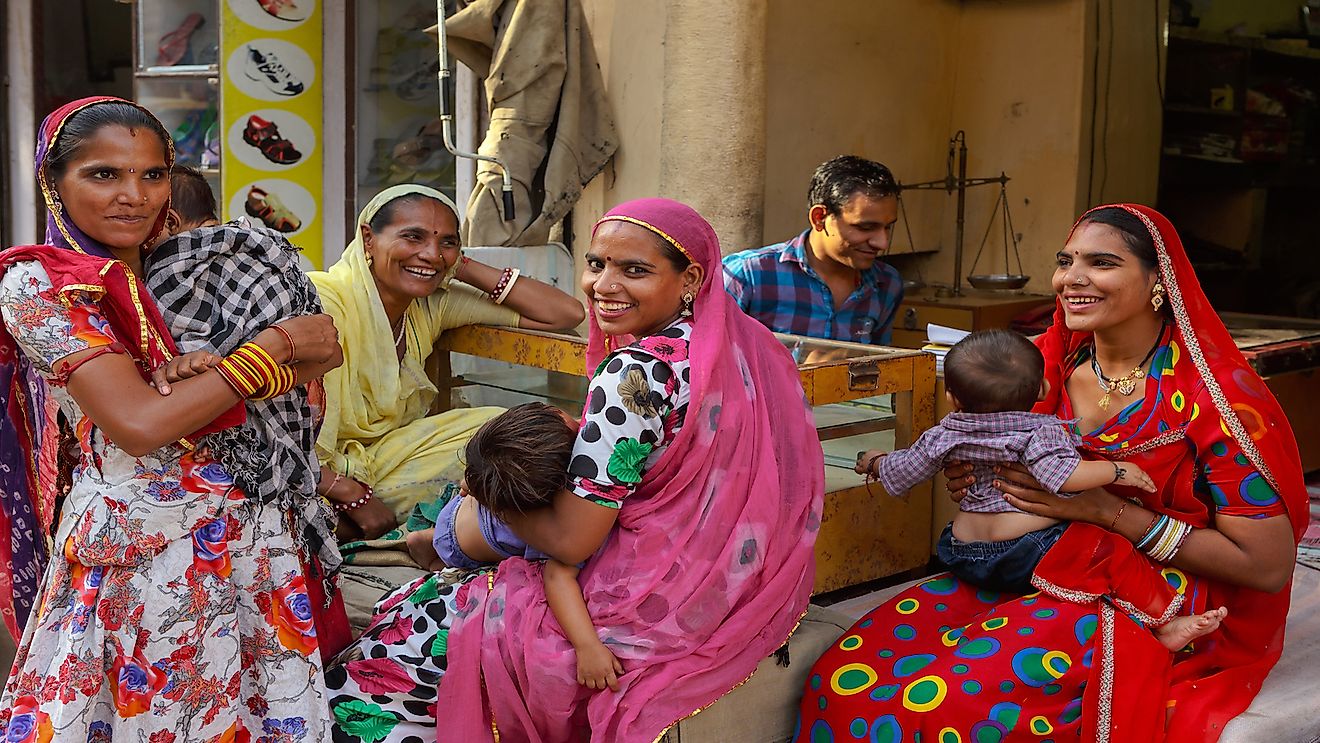India's Falling Fertility Rate: 1950 To 2020

India is set to become the most populous country by 2027 despite fertility declining to 2.2 children in 2020 from a fertility rate of 5.9 recorded in 1950. The country currently has about 1.37 billion people, the second-highest population after China, which has 1.4 billion people. India is expected to have an additional 230 million people by 2050. The government of India has struggled to control its population for decades. In 1952, India became the first nation to launch a family planning program aimed at lowering population growth. In the 1961 census, the country registered unprecedented growth, which led the government to set a target of reaching a crude birth rate of 25 per 1000 by 1972. The goal was not attained even by 2002. It seemed that India had overly optimistic demographic goals that were set out in documents and policy statements that were continuously postponed. In the 1980s, it became common practice to set goals of the net reproduction rate (NRR). In 1981, the goal of reaching NRR of one was set for the year 2000, but in the mid-1980s, plan documents postponed the target to the years 2006 to 2011. At the beginning of the 1990s, the target was pushed further to the years 2011 to 2016. In 2000, the country announced the National Population Policy, a move that was interpreted as a show of renewed commitment to population control. The new policy document aimed at the attainment of a fertility rate of 2.1 by 2010.
Fertility Trends In India
According to data collected from the Sample Registration System (SRS) – India’s vital fertility rates have fallen since 1971. The decline has, however, been occurring at a much slower rate than was originally expected. According to the source, the total fertility rate had fallen from an average of 5.1 children per woman recorded between 1971 and 1973 to an average of 3.2 children per woman recorded between 1996 and 1998. There is a possibility that the actual pace of decline was faster than suggested by the source since the completeness of birth reports was still improving. Further research has revealed that between 1981 and 1991, the SRS was underestimating adult mortality by 8-9% and the birth rate by 7%. The conclusion is supported by the application of the own-children method to the data in two rounds of the National Family Health Survey. The analysis revealed that the level of fertility was higher than the SRS estimate by 9.6% between 1978 and 1992, and by 6.8% between 1984 and 1998. The analysis showed that the SRS-based total fertility rate (TFR) estimates were on the lower side while the rate of fertility decline in India was underestimated. A similar result was obtained from an analysis of the preliminary results of the 2001 census.
Development Is The Best Contraception
Research suggests there is a complex relationship between fertility, composition, and distribution of the population. For example, urbanization is linked to more energy efficiency and lower fertility. Societies also generally experience falling fertility rates as incomes and education improve, child mortality declines, and more women work. The observations are summarized by the saying, “Development is the best contraceptive.” The case of India seems to support the theory. The states of Bihar, Rajasthan, Madhya Pradesh, Jharkhand, and Uttar Pradesh, which have the highest fertility rates also, have the lowest socioeconomic indicators, particularly among women. For example, Bihar, which has the highest rate of illiteracy among women (26.8%), also has the highest fertility rate (3.2%). By contrast, Kerala, which has low fertility rates, has the highest literacy rate (99.3%) due to a continued focus by the state on basic education and health care. The states of Uttar Pradesh and Bihar, along with Jharkhand, Chhattisgarh, Orissa, Madhya Pradesh, and Rajasthan, all have high rates of poverty and are the focus of increased family planning efforts.
Causes Of Fertility Decline
Rising levels of education, particularly among women, is regarded as a significant factor in fertility decline. In India’s fertility transition, the role of female education has also been touted as a critical factor. However, it is argued that India’s declining fertility has primarily been driven by a decline among illiterate women who are receptive to the idea of having fewer children but investing more in their future. It has been suggested that the declining rate of fertility is not only outpacing the nation’s education transition but also causing it. A breakdown of data on the change in fertility differentials by education shows that over half of the overall fertility decline was a result of fertility decline among illiterate women. An increase in female education only accounted for less than 20% of the decline. The contribution of female education on the increase in contraception is estimated to be 10-15%. That is not to mean that the influence of female education should be underestimated. Between 1992 and 1993, the fertility rate differentials by education were substantial. The total fertility rates (TFR) ranged between 4.0 among illiterate women and 2.3 among women who had completed middle school or above. In relative terms, the TFR was 43% lower among women who had completed middle school compared to illiterate women.
Illiterate Women Increasingly Investing In Children
Illiterate women are increasingly investing in their children by sending more of them to school, particularly first-born daughters who are then released of the burden of caring for younger siblings. Ease in accessing contraception among the general population and increased mass media exposure has also been identified as important factors that have led to declining fertility.
Below-replacement Level Fertility
According to data from the SRS, the states of Kerala and Tamil Nadu had below-replacement fertility (2.0) in 1998. There is a possibility that the total fertility rate will fall below the replacement level in many states going into the future. The desired family size has not fallen below two children in any of the states. The female age during the first marriage remains below 20 years, but that is likely to change in the future. Due to the tempo effect, it is expected that as age at marriage rises, period fertility rates are expected to decline even when cohort fertility is unaltered. Experts have also observed that the country is experiencing a considerable population decline even when the participation of women in the workforce is far below the expected level. For example, in urban areas, the total fertility rate is close to replacement levels, but less than a third of the women are included in the workforce. With the expected increase in women in the labor force, the desired family size is expected to reduce further and, therefore, the cohort fertility. To achieve below replacement rate, fertility rates in India will have to continue pushing its family planning programs aimed at reducing population size
Fertility Rates In Urban And Rural Areas
The Total Fertility rate (TFR) has more than halved in both rural and urban areas. In urban areas, the TFR has reduced to 1.7 from 4.1 recorded in 1971. In rural areas, the total fertility rate has declined from 5.4 to 2.4 in the same period. Only six of the twenty-two states have a total fertility rate of 2 or more in urban areas. Ten of the states have a TFR of less than 2 in rural areas. Fertility declines have been particularly sharp in India’s towns and cities where women are more likely to go to school, marry later, and work.
Fertility Declines In The 21 Century
In 2000, Indian women had a fertility rate of 3.3. Significant declines in fertility rates in the southern states, which have higher rates of literacy and greater gender equity, contributed considerably to the overall national fertility decline. In 2009, the fertility rate in India was 2.6 children per woman. The national decline in fertility rate, however, masks disparities among the states. The southern states were seen to have the lowest fertility rates, with Kerala having a total fertility rate of 1.7 in 2009. In 2016, the total fertility rate in India had declined to 2.3. The fertility rate dropped to 2.27 in 2017 and then to 2.24 in 2018. In 2019, the fertility rate was 2.22. In 2020, fertility is expected to be 2.20. The declining fertility rate is nearing the replacement rate of 2.1. The country’s future demographic trends will depend on the fertility rate that will be experienced in the northern states, which have some of the highest poverty rates, illiteracy, fertility, and the largest populations.
Investing In Contraception
The availability of modern contraceptives has not been able to keep up with the desire for smaller families in a majority of Indian states. In 2016, the government spent 85% of the funds allocated to family planning on female sterilization. The number of Indian women who have a choice of contraceptive methods such as injectable contraception or birth control pills remains high. Some have even suggested that the high abortion rates are an indicator of the unfulfilled need for contraception and birth spacing. Unsafe abortions in the country are responsible for a third of maternal deaths. In 2015, the country had five available methods of contraception; the pill, condoms, female and male sterilization, and Intrauterine devices. Contraceptive prevalence was, however, less than 50%, lower than Sri Lanka, Bangladesh, Indonesia, Bhutan, and Nepal. When injectable contraceptives were introduced in 2017, female sterilization remained the most popular birth control method. The government is stepping up investment in family planning and actively promoting the use of contraception.











